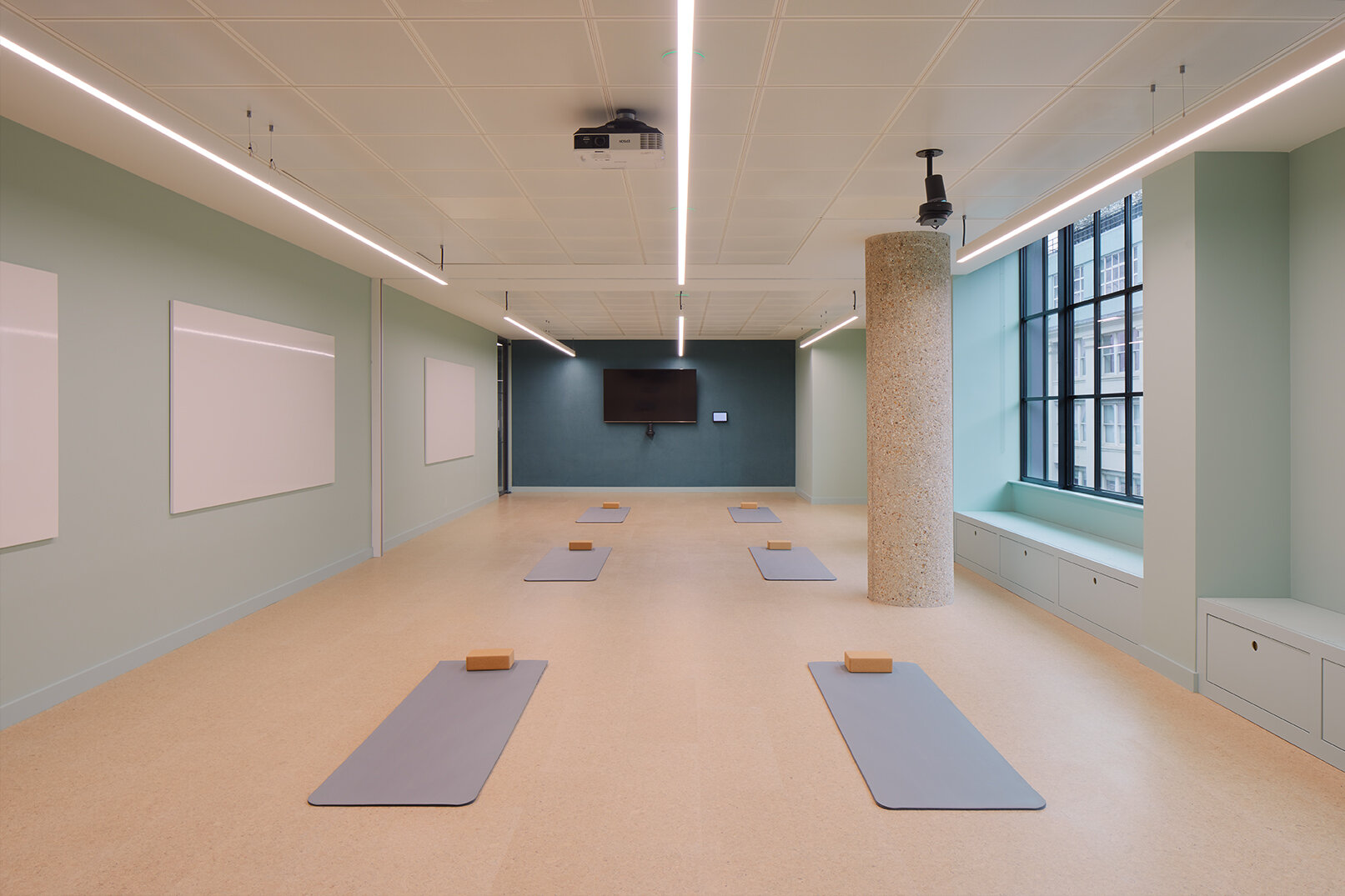Sustainable Surfaces in Office Interior Design
We used plenty of sustainable surfaces in our project for BenchSci including Cradle to Cradle Certified® Gold ceiling panels that reused the existing ceiling grid structure
Creating sustainable interiors is a must for businesses
We’re so happy that more and more of our clients are becoming more aware of sustainability regarding the interior design of their office space. Creating sustainable office interiors is an essential consideration for businesses looking to reduce their environmental footprint, put wellbeing at the forefront of decision making and create a healthier workspace. However, it’s a tricky business to make the ‘right’ choices because there are so many factors that make up what sustainability means. A product may have large recycled content for example but if during it’s manufacturing process, it’s used a lot of water or energy, transported in a non-sustainable way or isn’t durable then a new product that has been made with consideration and is long lasting might be the better option.
When we choose finishes and surfaces in our schemes, we try to make the best decisions we can, weighing up a lot of factors from how the products are manufactured, transported, who’s made them, what certificates etc.
When it comes to sustainable surfaces for office interiors, however, you can focus on the following materials and strategies as a good place to start:
We used Durat for the cafe counter for our Mirrorworks project. This is a colourful solid surface material made with recycled post-industrial plastics and is recyclable.
Recycled Materials:
Made and distribute in the sustainable ways, surfaces made from recycled content can be a really great and interesting thing. For example, recycled glass countertops, reclaimed wood paneling, and recycled metal accents can be used in various office applications. Just bear in mind that while recycled materials can contribute to sustainability by reducing the need for new resource extraction and waste generation, their overall sustainability depends on various factors, including how they are produced, used, and managed throughout their lifecycle.
Low VOC (Volatile Organic Compounds) Finishes:
VOCs are harmful chemicals that can off-gas from paints, adhesives, and finishes, contributing to indoor air pollution. Opt for low-VOC or VOC-free paints, finishes, and adhesives to improve indoor air quality.
Bamboo:
Bamboo is a fast-growing, renewable resource that can be used for flooring, countertops, and wall coverings. It's durable and has a unique, natural appearance.
Cork:
Cork is a sustainable material harvested from the bark of cork oak trees. It can be used for flooring, wall coverings, and bulletin boards. It's naturally renewable and biodegradable. Other benefits are it’s resistance to water and sound absorbency capabilities.
Our training room / yoga studio for MVF Global featured cork flooring. An excellent sustainable surface with a soft texture and great sound absorbency
Linoleum:
Linoleum is often a surprise sustainability-wise for our clients but it’s made from natural ingredients like linseed oil, wood flour, and cork dust. It's durable, long-lasting, and available in a wide range of colours and patterns. When considering linoleum for a project, look for products that have third-party certifications, such as FloorScore or GreenGuard, to ensure they meet environmental and indoor air quality standards. Additionally, responsible installation and maintenance practices can further enhance the sustainability of linoleum flooring.
Whenever real wood is selected in our projects, we always make sure it’s FSC
Sustainable Wood:
When using wood surfaces, choose wood that is certified by organisations like the Forest Stewardship Council (FSC), which ensures responsible forest management practices.
Concrete:
Concrete surfaces can be sustainable if made with a high percentage of recycled content, and they are durable and long-lasting.
Paper-Based Products:
Some companies offer paper-based surfaces made from recycled paper and resin. These surfaces can be used for countertops and wall coverings. Just make sure that they are suitable for commercial surfaces.
Reclaimed and Salvaged Materials:
Re-use is always the best sustainable choice if it’s suitable for the project. Consider using reclaimed or salvaged materials, such as old barn wood, industrial machinery parts, or reclaimed bricks for unique and sustainable office surface solutions. It does take effort to ensure that the use of re-used materials is appropriate for a scheme but the added characterful and unique benefits this can bring to a project are so worth it.
Modular Systems:
Modular wall and floor systems allow for easier reconfiguration and reuse of materials when office layouts change, reducing waste and the need for new resources.
Natural Stone:
While natural stone surfaces are durable and long-lasting, it's important to source them responsibly to minimise the environmental impact. Look for suppliers who adhere to sustainable quarrying practices.
Durability:
Select surface materials that are known for their durability and longevity. Longer-lasting surfaces reduce the need for replacements and minimise waste over time.
In our MVF Global project, our contractor had leftover marble which we managed to make use of in the tea points
In our project for BenchSci, we sourced Tarkett’s Retrace carpet tiles. Cradle to Cradle Gold certified, they were selected for their low circular carbon footprint. Made from 100% recycled yarn, with an EcoBased backing, these tiles are also 100% recyclable at end of life.
Local Sourcing:
Whenever possible, source materials locally to reduce transportation-related carbon emissions.
Recyclable Materials:
Choose materials that can be recycled at the end of their lifespan. Some carpet tiles and acoustic panels, for example, can be recycled.
Energy-Efficient Lighting:
While not a surface material, incorporating energy-efficient LED lighting can reduce energy consumption and contribute to sustainability efforts within the office.
Designing with sustainability in mind is no easy feat but it’s well worth the effort. When designing sustainable office interiors, it's crucial to consider the entire lifecycle of the materials, from production to disposal. Additionally, certifications like LEED (Leadership in Energy and Environmental Design) can guide you in selecting environmentally friendly materials and practices for your office project.
Get in touch if you’d like help designing your sustainable office.
Author: Nadia Themistocleous, Lead Interior Designer, Trifle*
Nadia has worked with Trifle* for over seven years and has been the interior lead for some of our most ambitious projects to date including MVF, BenchSci and TriliTech. Prior to Trifle* and managing her own interior design company, she worked for a decade in advertising and the music industry creating and executing creative campaigns and events. She is passionate about translating our client’s culture, identity or ways of working into the spaces they inhabit ensuring that every space created for our clients is as unique as their business or home is.







